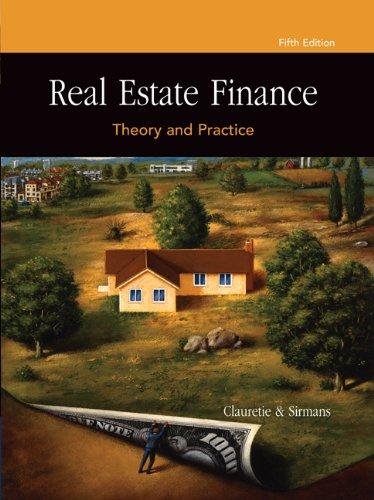Answered step by step
Verified Expert Solution
Question
1 Approved Answer
After graduating from the University of Texas with a degree in Finance, Stan Morgan took a position as a stockbroker with Morgan Stanley in Austin.
After graduating from the University of Texas with a degree in Finance, Stan Morgan took a position as a stockbroker
with Morgan Stanley in Austin. Although he had several college loans to make payments on his goal was to set aside
funds for the next ten years to make a down payment on a house. After considering the various suburbs of Austin,
Stan chose Round Rock as his desired future residency. Based on median house price data, he learned that threebedroom,
twobath houses currently have a median price of $ To avoid paying Private Mortgage Insurance PMI Stan
wanted to make a down payment of
Because it will be ten years before Stan buys a house, the $ price will surely not be the same in the future. To
estimate the rate at which the median house price will increase, he considered the historical price appreciation in Round
Rock. In the past, homes appreciated by per year. Stan decided to use this estimation in his calculations.
Morgan Stanley offers several opportunities for Stan to invest the funds that will be devoted to the down payment toward
his future home. He feels that a balanced account of stocks, bonds, and government securities would realistically achieve
an annual rate of return of
Questions:
Taking into consideration that the $ median home price will grow at per year, what will be the future
median home selling price in Round Rock in ten years?
Based on your answer from number what amount will Stan Morgan have to accumulate as a down payment if
he does decide to buy a house in Round Rock?
Based on your answer from number how much will Stan need to deposit into the Morgan Stanley balanced
account which earns per year at the end of each month to accumulate the required down payment?
If Stan decides to make deposits once a year at the end of each year deposits into the Morgan Stanley account,
how much would these deposits be
Take your answer from number and multiply it by to determine Stans total deposits per year when making
monthly deposits. Compare that to your endofyear deposit answer from number Explain why Stans total
deposits per year when making monthly deposits is less than when making one annual deposit per year.
If homes in Round Rock appreciate by per year over the next ten years instead of the assumed what is
Stans revised needed down payment and how much would Stan have to deposit at the end of each month to make
that down payment?
If homes in Round Rock appreciate by only per year over the next ten years instead of the assumed what
is Stans revised needed down payment and how much would Stan have to deposit at the end of each month to
make the down payment?
If Stan decided to deposit his down payment funds in less risky lowgrowth investments earning only instead
of how much would he have to deposit at the end of each month to make the down payment? Use the down
payment needed from number for this calculation.
a If Stan decides to make deposits once per year at the end of the year into this lessrisky account, how
much would these deposits be
If Stan decided to deposit his down payment funds in riskier highgrowth investments earning a return of
instead of how much would he have to deposit at the end of each month to make the down payment? Use
the down payment needed from number for this calculation.
a If Stan decides to make deposits once per year at the end of the year into this riskier account, how much
would these deposits be
Based on your calculations, should Stan make end of month or end of year deposits? Why?
Based on this information, do you recommend he deposit his funds in the balanced account with expected
return, the low growth, less risky, investments with expected return, or the high growth, riskier, investments
with expected return? Why?
Step by Step Solution
There are 3 Steps involved in it
Step: 1

Get Instant Access to Expert-Tailored Solutions
See step-by-step solutions with expert insights and AI powered tools for academic success
Step: 2

Step: 3

Ace Your Homework with AI
Get the answers you need in no time with our AI-driven, step-by-step assistance
Get Started


